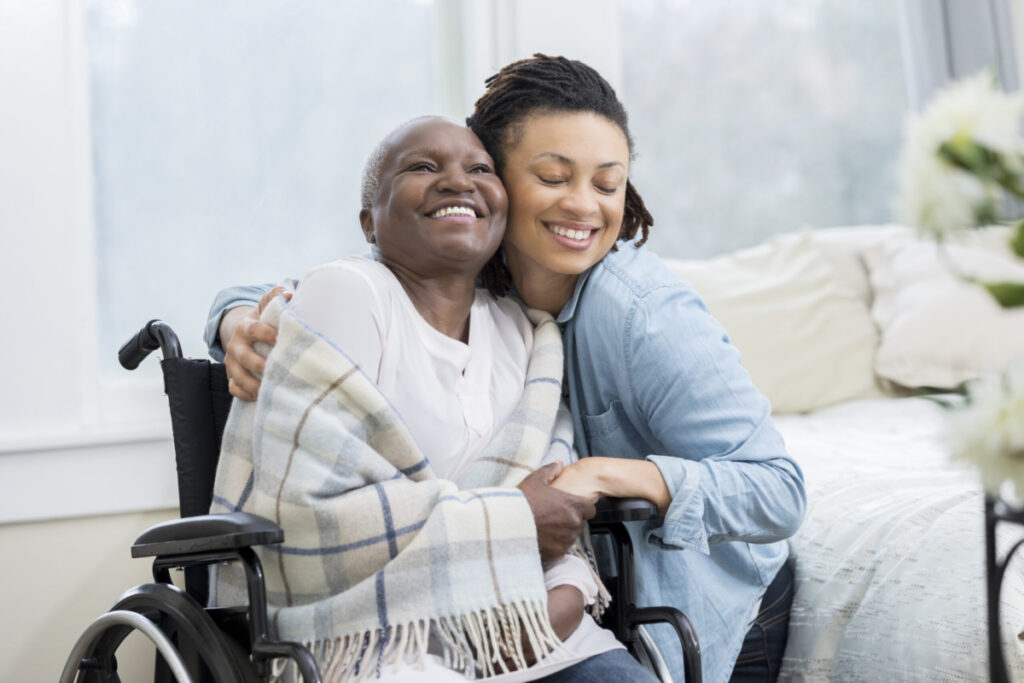On Apr. 29, 2021, the RAISE Family Caregiving Advisory Council convened to hear presentations from the members of the Older Adults Equity Collaborative (OAEC) about diversity and access to caregiver supports, and from the University of Massachusetts Boston and Community Catalyst about listening sessions with aging and disability organizations. The council also reviewed and discussed its initial report to Congress. It was then voted into clearance by the Council.
Click here to download slides.
Inspiration from the Acting Administrator
The meeting began with welcoming remarks from the council chair, Acting Administrator and Assistant Secretary for Aging at the Administration for Community Living (ACL), Alison Barkoff. She spoke about her lifelong commitment to advocating for community living for people with disabilities and older adults, and praised the work of the Committee, commending them for their person-centric approach and their bold ideas. Barkoff also spoke about the challenges of COVID, both for caregivers and for those receiving support. Equity for diverse groups of caregivers was another focus of the introduction, with Barkoff stressing the importance of making supports accessible to LGBTQ individuals and families of color. Finally, Barkoff shared her experiences as a family caregiver and praised the committee for their balancing of the committee work with their responsibilities as caregivers during the COVID-19 pandemic.
Older Adults Equity Collaborative (OAEC) Presentation
Elena Kieffer, the Acting Director of the New York Academy of Medicine’s Center for Healthy Aging, introduced the Older Adults Equity Collaborative (OAEC) work to ensure access and equity in aging services programs and bring a diversity lens to caregiving. This was followed by brief presentations from each of the member organization: MHP Salud, the National Asian Pacific Center on Aging (NAPCA), the National Indian Council on Aging (NICOA), the National Center and Caucus on Black Aging (NCBA), and Services and Advocacy for LGBT Elders (SAGE).
MHP Salud
Shannon Patrick, Program Director of MHP Salud, presented the characteristics of Hispanic/Latino older adults and families, the challenges they face, and recommendations. The Latino population is very diverse with a variety of countries of origin. Nearly two-thirds speak Spanish at home. The population of Hispanic family caregivers is growing, and a large portion are young (between ages 18 and 34). Immigration (acculturation, mixed status families, and immigration-related trauma), medical mistrust, and cultural beliefs have a large influence on caregiving and medical decision making.
Latino family caregivers face unique challenges. They are more likely to:
- Live in multigenerational homes with the care recipient
- Be in high intensity/high burden caregiving situations (taking on nursing/medical tasks, managing more than one chronic condition, and providing more care hours)
- Experience negative health effects and financial strain
- Lack culturally appropriate materials and medical staff
Their recommendations include:
- Awareness and outreach efforts
- Need for culturally and linguistically appropriate care
- Services and supports to address the higher caregiver burden
- Solutions that address financial barriers
- Reliable funding for community health workers
The National Asian Pacific Center on Aging
Joon Bang, President and CEO of the National Asian Pacific Center on Aging, presented about the diversity of the Asian American Pacific Islander (AAPI) population, the importance of cultural awareness, AAPI caregivers, and recommendations. AAPIs are a heterogeneous group representing more than 50+ unique cultural and racial identities originating from the Asian continent or the Pacific islands and represent over 100 spoken languages.
AAPI caregivers are:
- More likely to live in multigenerational households
- Less likely to place their older family members into a facility
- More likely to believe that caring for parents is expected of them
- More likely to be caring for an older adult than the general population
Their recommendations include:
- Requiring the collection of disaggregated data for all federally funded caregiver programs
- Requiring cultural competency training for all federally funded caregiver programs
- Requiring culturally and linguistically competent and appropriate materials
- Prioritizing affordable and in-language referrals
- Establishing in-language caregiver support groups and networks on the federal level
- Providing as a national resource in-language caregiver education/training workshops
- Utilizing culturally competent, trained medical Interpreters when speaking to AAPI family caregivers
- Editing caregiver burden screening tools to collect information about caregiving responsibilities
The National Indian Council on Aging
Rebecca Owl Morgan, Project Coordinator of the National Indian Council on Aging, presented about the unique characteristics of American Indian/Alaskan Native caregivers and recommendations. There are 574 federally recognized tribes and 60 state recognized tribes in the United States. American Indians/Alaskan Natives view caregiving as part of family life and can be reluctant to use formal caregiving services.
Their recommendations include:
- Awareness and outreach efforts
- Training healthcare partners to provide educational resources to caregivers when they accompany patients to appointments, and community health representatives to focus a portion of their home visits on the needs of caregivers
- Services and supports for caregivers including support groups, improved respite, increased access to pharmacies with longer varied hours, and education and training for caregivers
- Financial and workplace security including flexible schedules and free or low cost financial and legal assistance
- More research including tracking the number of family caregivers in Indian Country
The National Caucus & Center on Black Aging
Keisha Lewis, a consultant with the National Caucus & Center on Black Aging, presented about the characteristics of African American and black caregivers and considerations for the Council. African American and black caregivers are more likely to be women, younger, and “sandwiched” between caring for more than one person. Caregiving is especially common within the mother-daughter dyad. Regardless of gender, most African American and black caregivers work while caregiving and report at least one negative impact on their work due to their caretaking role. They also report experiencing financial impacts as a result of providing care.
Their considerations focus on six primary actors: employers, banks and financial institutions, government, media, technology, and transportation. Key recommendations include:
- Expanding the definition of family
- Offering dependent care assistant plans and flexible spending accounts
- Providing caregiver financial planning resources
- Granting fiduciary caregivers access to credit protection tools for care recipients
- Providing culturally appropriate collateral materials and media outreach
- Addressing the digital divide
- Raising awareness of transportation services
Advocacy & Services for LGBT Elders
Sherrill Wayland, Director of SAGE’s National Education Initiatives, presented about family caregiving in the LGBT community and their recommendations. She stressed the importance of intersectionality as well as the fact that these intersections can cause greater challenges when trying to access long-term services and supports. In the LGBT community, caregiving often comes from family of choice (friends or community members that have become family). LGBT caregivers often care in isolation, risking stress and burnout. They also experience more workplace insecurity because families of choice do not benefit from the Family and Medical Leave Act (FMLA).
Their recommendations include:
- Person centered supports that require LGBT cultural competency training of all federally funded caregiving programs
- Workplace security that promotes including family caregivers with significant relationships in policies such as FMLA
- Research and evidence-based practices that require all federally funded research to be inclusive of sexual orientation and gender identity
Older Adults’ Equity Collaborative Coordinating Center
Elena Kieffer closed the presentation by identifying five key crosscutting themes for marginalized caregivers: intersectionality, cultural expectations, language barriers, nontraditional family structures and financial burden. She also noted the additional themes of difficulty navigating federal/state benefit programs, distrustful attitudes toward the US government, the prohibitive costs of aging-in-place, and fear of discrimination in institutionalized settings.
Listening Sessions’ Presentation
Carol Reagan, Senior Advisor for the Center for Consumer Engagement in Health Innovation at Community Catalyst, and Pamela Nadash, Associate Professor at the Department of Gerontology of the University of Massachusetts McCormack Graduate School, presented on the results of the stakeholder listening sessions. They explained that they identified a range of stakeholders and thought leaders on different caregiver issues, inviting disability groups, providers, researchers, and advocates. Ultimately, 42 organizations participated in 6 two-hour sessions, reviewing the five goals of the RAISE Council and suggesting concrete actions for achieving these goals. Some of their ideas included:
- Launching a major public awareness campaign to make caregivers aware of services, and to help more caregivers self-identify, since many of them feel that caregiving is just something that one does for someone they love (Goal 1)
- Creating an inventory of caregiver assessment tools to identify the best assessment tools for different scenarios (Goal 2)
- Improving availability of culturally appropriate services and increased funding for services and supports, such as home modification (Goal 3)
- Expanding paid family leave in a way that is inclusive of families of choice (Goal 4)
- Developing a standard data set and caregiver definition to be used in surveys to make data easier to analyze and compare (Goal 5)
Reagan and Nadash discussed the importance of including stakeholders such as healthcare professionals and employers in policy conversations, while stressing the importance of involving caregivers in every level of policymaking. Committee members shared their thoughts on the presentation, agreeing with the importance of culturally competent resources and awareness campaigns, and stressing that caregiver activism is crucial to ensuring that caregiver needs are respected and their goals are put into action.
Initial Report to Congress – Final Review and Discussion | Vote into Clearance
The Council discussed the initial report to Congress. Members of the Council believed that the report’s clear organization and personal vignettes were its greatest strengths. They unanimously voted the report into clearance. The Council also discussed how it can support state and local partners in implementing a national strategy, the timeline of its work, and the dissemination strategy for the report to Congress.
Next Steps
After completing clearance, the report will move to layout and design. Meanwhile, the subcommittees of the Council will reconvene In May and June 2021 to begin work on a national strategy, providing concrete actions and timelines under each of the goals and recommendations that are in the report to Congress.



